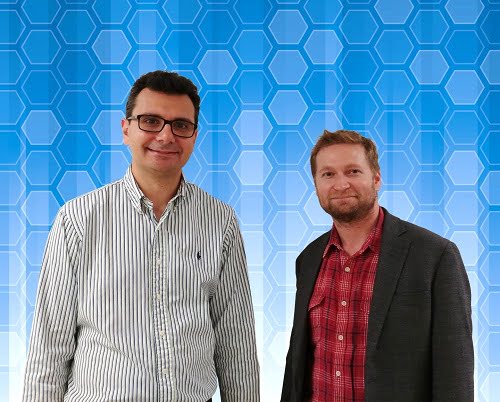The Department of Energy’s (DOE) Office of Science has awarded two research teams, each headed by a member of Oak Ridge National Laboratory's (ORNL) Quantum Information Science Group, $10.5 million over five years to both assess the feasibility of quantum architectures in addressing big science problems and to develop algorithms capable of harnessing the massive power predicted of quantum computing systems.

ORNL's Pavel Lougovski (left) and Raphael Pooser will lead research teams working to advance quantum computing for scientific applications. Courtesy of Oak Ridge National Laboratory, US Department of Energy.
The two projects are intended to work in concert to ensure synergy across DOE's quantum computing research spectrum and maximize mutual benefits. ORNL's Raphael Pooser will oversee an effort titled, "Methods and Interfaces for Quantum Acceleration of Scientific Applications," part of the larger Quantum Computing Testbed Pathfinder program funded by DOE's Advanced Scientific Computing Research office.
Pooser's team, which includes partners from IBM, IonQ, Georgia Tech and Virginia Tech, received $7.5 million, to be distributed over five years, to evaluate the performance of a suite of applications on near-term quantum architectures. The project aims to work with industry leaders to understand the potential of quantum architectures in solving scientific challenges on the scale of those being tackled by DOE. ORNL will focus on scientific applications spanning three fields of study: quantum field theory, quantum chemistry and quantum machine learning.

"Quantum applications that are more exact and faster than their classical counterparts exist or have been proposed in all of these fields, at least theoretically," Pooser said. "Our job is to determine whether we can get them to work on today's quantum hardware and on the hardware of the near future."
To increase their chances of success, Pooser's team will work closely with his ORNL colleague Pavel Lougovski, who is overseeing the "Heterogeneous Digital-Analog Quantum Dynamics Simulations" effort — which has received $3 million over three years. Lougovski has partnered with the University of Washington's Institute for Nuclear Theory and the University of the Basque Country UPV/EHU in Bilbao, Spain, to develop quantum simulation algorithms for applications in condensed matter and nuclear physics, specifically large-scale, many-body systems of particular interest to DOE's Office of Science.
Lougovski's team will pursue an algorithm design approach that combines best features of digital and analog quantum computing with the end goal of matching the complexity of quantum simulation algorithms to available quantum architectures. Because development and deployment of quantum hardware is a nascent field compared to traditional computing platforms, the team will also harness the power of hybrid quantum systems that use a combination of quantum computers and traditional processors.
"We have assembled a multidisciplinary team of computer scientists, applied mathematicians, scientific application domain experts and quantum computing researchers," Lougovski said. "Quantum simulation algorithms, much like our team, are a melting pot of various quantum and classical computing primitives. Striking a right balance between them and available hardware will enable new science beyond the reach of conventional approaches."
Oak Ridge National Laboratory is an American multi-program science and technology national laboratory sponsored by the U.S. Department of Energy.